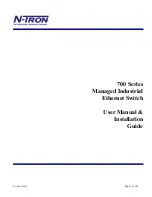
29. Layer 3 Switching
ROX™ v2.2 User Guide
290
RuggedBackbone™ RX5000
29.1.3. Static Layer 3 Switching Rules
When creating a static route through switch management, you can explicitly configure it to be hardware-
accelerated. If hardware acceleration is selected, an appropriate Layer 3 switching rule is installed in
the ASIC’s TCAM and never ages out.
29.1.4. Dynamic Learning of Layer 3 Switching Rules
For static routes without hardware acceleration or for dynamic routes, Layer 3 switching rules can be
dynamically learned based on software router and firewall decisions. For example, the Layer 3 switch
can automatically decide to offload some flows from the router into the Layer 3 Forwarding Table.
After a certain amount of traffic for the same flow is successfully routed, the Layer 3 switching ASIC
begins switching the rest of the packets belonging to the same flow. A flow is unidirectional traffic
between two hosts. For example, the traffic from 192.168.10.1/24 TCP port 1789 to 192.168.20.1/24
TCP port 1623 is a flow. Traffic in the opposite direction constitutes another flow.
The RuggedBackbone™ Layer 3 Switch supports different modes of dynamic rule learning.
Flow-oriented learning is when the switch uses the following information to identify a traffic flow:
• Source IP address
• Destination IP address
• Protocol
• Source TCP/UDP port
• Destination TCP/UDP port
This learning method is more granular and requires more ASIC resources, but it provides more flexibility
in firewall configuration as the rule takes the protocol and TCP/UDP port into consideration to make
forwarding decisions.
Host-oriented learning is when the switch uses the following information to identify a traffic flow:
• Source IP address
• Destination IP address
This learning method provides less flexibility in firewall configuration, as the user can allow or disallow
traffic between two hosts.
For unicast traffic, each flow constitutes one rule. For multicast routing, one multicast route may
constitute several rules. For more information, see
Section 29.1.6, “Layer 3 Multicast Switching”
The Layer 3 switch continuously monitors activity (this is, the presence of traffic) for dynamically learned
rules. Because of this, dynamically learned rules may be removed after a configurable time due to
inactivity.
29.1.5. Layer 3 Switch ARP table
A router needs to know the destination host or next-hop gateway MAC address for it to forward a packet
on the other subnet. Therefore, software maintains an ARP (Address Resolution Protocol) table that
maps IP addresses to MAC addresses. The same information is also needed by the Layer 3 switching
ASIC when it switches IP packets between subnets.
The destination or gateway MAC address is usually obtained through ARP. However, ARP entries can
also be statically configured in the Layer 3 Switch so that they do not time out. When configuring a static
ARP entry, if no value is entered for the MAC Address parameter, the address is automatically resolved
through ARP and then saved statically. This is preserved across reboots of the device.
For a static Layer 3 switching rule, the destination MAC address for the rule is always resolved, and
is also saved statically.
















































